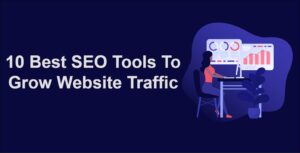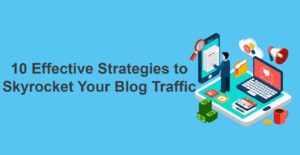Blogging has changed from a hobby to a way to make money for many people. But turning your blog into a steady source of income needs planning, hard work, and knowing how to increase your blog’s revenue.
Advancing your blog revenue requires creativity, strategy, and dedication. You can successfully turn your passion into a profitable venture by implementing diverse revenue-generation techniques, offering valuable content, and building meaningful relationships with your audience.
Success doesn’t happen overnight; it results from continuous effort, adaptation, and a commitment to delivering quality to your readers. With these proven Tips To Increase Your blog Revenue, you will see a definite growth in your blog revenue and achieving your financial goals.
In this comprehensive guide, we’ll delve into proven strategies that can help you boost your blog revenue and turn your passion into a profitable venture.
5 Tips To Increase Your blog Revenue
Before we delve into the techniques, it’s important to understand the various ways in which bloggers can generate revenue:
1. Advertising Revenue
Advertising revenue for a blog is the income generated by displaying advertisements on your blog. Advertisers pay you based on different models, such as cost per click (CPC) or cost per thousand impressions (CPM). As your blog’s traffic grows, more people see the ads, potentially increasing your earnings.
Here are a few examples:
- Google AdSense: You place AdSense ads on your blog, and when visitors click on those ads, you earn a portion of the ad revenue.
- Sponsored Content: Brands pay you to write a post about their products or services and promote it on your blog.
- Affiliate Marketing: You promote products or services through your blog with affiliate links. When readers make a purchase through those links, you earn a commission.
- Direct Ads: Companies approach you directly to display their ads on your blog for a set fee.
- Native Advertising: Integrating ads seamlessly within your content, making them appear less intrusive.
- Display Ads: Banner or display ads that appear in the header, sidebar, or within the content of your blog posts.
How much money can be through Advertising Revenue?
The revenue generated from advertising on a blog can vary widely and depends on several factors:
- Traffic: Blogs with higher traffic generally have the potential to earn more ad revenue as more people see the ads.
- Niche: Blogs in popular or competitive niches may have more advertisers willing to pay for ad space.
- Ad Placement: Strategic ad placement within your content or in visible areas like headers and sidebars can impact earnings.
- Ad Type: Different ad types (CPC, CPM, sponsored posts, affiliate marketing) have varying payout rates.
- Audience Engagement: An engaged audience that clicks on ads or converts through affiliate links can boost revenue.
- Advertiser Demand: The demand from advertisers within your niche affects ad rates.
- Ad Network: The ad network you choose, such as Google AdSense, Media.net, or affiliate programs, can influence earnings.
As a rough estimate, some bloggers earn a few hundred dollars per month, while others generate thousands or even tens of thousands.
2. Affiliate Marketing
Affiliate revenue is a way bloggers can makes money by promoting products or services through affiliate links. When a reader clicks on your affiliate link and makes a purchase, you earn a commission.
One of the bloggers’ most effective methods to monetize their content is through affiliate revenue. And it is one of our favorite Tips To Increase Your Blog Revenue.
This strategy revolves around promoting products or services through affiliate links, ultimately translating recommendations into earnings.
The Process Unveiled:
- Exploring Affiliate Programs: Begin by joining affiliate programs. Numerous platforms like Amazon Associates, ShareASale, and CJ Affiliate offer a plethora of options for various niches.
- Strategic Product Promotion: Craft content that seamlessly integrates the products you want to promote. It could be product reviews, recommendations, or how-to guides.
- Incorporating Affiliate Links: Embed your unique affiliate links within your content. These links are the bridge between your audience and the products you endorse.
Examples of Affiliate Revenue:
- Fitness and Nutrition Blog: Imagine running a fitness and nutrition blog. You might review fitness equipment, recommend supplements, and provide workout guides. By including affiliate links to these products, you enable readers to purchase them, leading to commissions.
- Travel and Adventure Blog: For a travel blog, you could showcase travel essentials like luggage, accessories, or booking platforms. As your readers make travel arrangements through your affiliate links, your revenue grows.
Affiliate marketing is not a get-rich-quick scheme; it requires consistent effort, strategic content creation, and building trust with your audience.
3. Sponsored Content
Sponsored content is a form of collaboration between bloggers or content creators and brands. It involves creating content that promotes a brand’s products or services in exchange for compensation.
This type of content is usually clearly labeled as “sponsored” to ensure transparency with the audience. Sponsored content can come in various formats, such as blog posts, videos, social media posts, and more.
Examples of Sponsored Content:
- Fashion Blog: A fashion blogger partners with a clothing brand to create a blog post showcasing the brand’s latest collection. The blogger models the clothing and provides a review of the quality, fit, and style.
- Travel Blog: A travel blogger collaborates with a hotel chain to write a blog post about their recent stay at one of the chain’s resorts. The post includes details about the accommodations, amenities, and the blogger’s overall experience.
- Fitness Blog: A fitness blogger teams up with a nutrition supplement company to create a video tutorial on incorporating their products into a healthy diet. The blogger demonstrates how to use the supplements and explains their benefits.
- Tech Blog: A tech blogger partners with a smartphone company to write a review of their latest device. The blogger discusses the device’s features, performance, and user experience.
- Home Decor Blog: A home decor blogger collaborates with a furniture brand to create a series of Instagram posts showcasing different pieces of furniture in a beautifully styled home setting.
4. Selling Products/Services
Selling products or services through a blog involves creating and promoting items that are directly related to the blog’s niche or content. This revenue strategy allows bloggers to leverage their expertise and audience to generate income by offering valuable products or services to their readers.
Examples of Selling Products/Services on a Blog:
- Ebook or Online Course: A food blogger with expertise in healthy cooking offers an ebook containing a collection of nutritious recipes and cooking tips. Alternatively, they might create an online course teaching subscribers how to prepare balanced meals.
- Handmade Crafts: A DIY and craft blogger sells handmade crafts, such as personalized home decor items, jewelry, or custom artwork. The products align with the blog’s focus on creativity and DIY projects.
- Consulting Services: A business strategy blogger offers one-on-one consulting services to help small businesses improve their online presence. They provide personalized advice and strategies based on their expertise.
- Fitness Equipment: A fitness blogger sells workout equipment, such as resistance bands, yoga mats, or dumbbells, that their audience can use to follow along with their workout routines.
- Beauty Products: A beauty and skincare blogger launches their own line of skincare products, including cleansers, moisturizers, and serums. The products are formulated based on their knowledge of skincare ingredients.
- Photography Services: A travel blogger offers photography services for destination photoshoots. Readers who admire the blogger’s travel photography can now hire them to capture their own travel memories.
5. Subscription Models
Subscription models for blogs involve offering exclusive content, resources, or benefits to subscribers who pay a recurring fee. This revenue strategy enables bloggers to provide premium content to their most dedicated followers while generating a steady income stream.
Examples of Subscription Models for Blogs:
- Membership Access: A fitness blog offers a premium membership that gives subscribers access to advanced workout plans, personalized coaching, and exclusive videos not available to regular readers.
- Newsletters: A technology blog offers a subscription-based newsletter with in-depth analysis, industry insights, and early access to product reviews. Subscribers receive valuable information directly in their inbox on a regular basis.
- Educational Content: An educational blog focused on a specific subject, like finance or personal development, offers a subscription plan that provides subscribers with in-depth courses, workshops, and interactive lessons.
Proven Techniques to Increase Blog Revenue
Let’s explore effective strategies to boost your blog revenue and achieve financial success:
1. Diversify Your Income Streams
Diversifying income streams for blogging involves expanding the sources from which a blogger generates revenue. Relying on a single revenue strategy can be risky, as changes in market trends or audience preferences could impact earnings.
By diversifying income streams, bloggers can create a more stable and sustainable source of revenue while catering to various audience needs.
Diversifying income streams helps bloggers create a more stable and sustainable source of revenue,
| Income Stream | Description | Examples |
| Advertising & Sponsorships | Monetize through ads and collaborations with brands. | Display ads, sponsored posts, brand partnerships. |
| Affiliate Marketing | Promote products/services and earn commissions on sales. | Amazon Associates, ClickBank, ShareASale. |
| Selling Digital Products | Create and sell ebooks, courses, printables, or guides. | Online courses, ebooks, printables. |
| Subscription Models | Offer exclusive content, ad-free experiences, or premium features. | Membership sites, Patreon, premium content. |
| Sponsored Content | Partner with brands for paid content creation and endorsements. | Sponsored blog posts, product reviews. |
| Freelance Services | Leverage expertise to offer services like content writing or consulting. | Content creation, social media management. |
| Physical Products | Sell merchandise, branded products, or related items. | Branded merchandise, merchandise store. |
| Consulting & Coaching | Offer expertise through consulting or coaching services. | Business consulting, life coaching. |
| Speaking Engagements & Workshops | Earn income by speaking at events or hosting workshops. | Public speaking events, educational workshops. |
2. Create High-Quality Content
Creating high-quality content is a crucial strategy for increasing blog revenue. High-quality content not only attracts and engages readers but also enhances your blog’s credibility and authority in your niche. This, in turn, leads to various benefits that contribute to higher blog revenue:
- Improved User Experience: High-quality content provides value to your audience by addressing their needs, concerns, and questions. This positive user experience encourages readers to stay longer on your blog, explore more pages, and potentially convert into loyal followers or customers.
- Higher Search Engine Rankings: Search engines like Google prioritize quality content that answers searchers’ queries. When your content is well-researched, informative, and relevant, it’s more likely to rank higher in search results, attracting organic traffic and increasing visibility.
- Increased Traffic: Quality content often gets shared and linked to by other websites and bloggers. This natural backlinking helps drive referral traffic, expanding your blog’s reach and potentially attracting a wider audience.
- Better Conversion Rates: High-quality content positions you as an expert in your field. When readers trust your expertise, they’re more likely to take desired actions, such as signing up for your newsletter, downloading resources, or making purchases.
- Monetization Opportunities: Quality content can be leveraged for various monetization strategies, such as affiliate marketing, sponsored content, or selling digital products. Businesses are more likely to partner with you if your content showcases your authority and audience engagement.
- Audience Engagement: High-quality content encourages readers to leave comments, share their opinions, and interact with your blog. Engaged readers are more likely to participate in discussions, sign up for updates, and become loyal supporters.
- Long-Term Value: Quality content has a longer shelf life. Evergreen articles that remain relevant over time can continue to attract traffic, generate leads, and contribute to revenue long after they’re published.
- Positive Reputation: Consistently delivering valuable content builds a positive reputation for your blog. This reputation attracts both readers and potential collaborators, further boosting revenue opportunities.
- Social Media Amplification: When your content is of high quality, readers are more likely to share it on social media platforms. This amplification increases your blog’s exposure and draws more traffic, potentially leading to higher revenue.
- Subscriber Growth: Quality content is a magnet for subscribers. As readers find value in your content, they’re more likely to subscribe to your email list, giving you a direct channel to communicate, market, and convert.
3. Implement SEO Strategies
Implementing SEO (Search Engine Optimization) strategies can significantly contribute to increasing blog revenue by driving more organic traffic to your blog and enhancing its visibility.
Here’s how SEO strategies can help boost your blog revenue:
- Increased Organic Traffic: By optimizing your blog content for relevant keywords and providing valuable information, you can improve your blog’s search engine rankings. Higher rankings lead to increased organic traffic, as users are more likely to click on results appearing on the first page of search engine results.
- Targeted Audience: Effective SEO allows you to target specific keywords and phrases that your target audience is searching for. This brings in visitors who are genuinely interested in your content, products, or services, increasing the chances of conversions.
- Better User Experience: SEO involves optimizing the technical aspects of your website, such as page load speed, mobile responsiveness, and user-friendly navigation. A well-optimized site provides a better user experience, leading to longer dwell times, lower bounce rates, and higher engagement – factors that search engines consider when ranking sites.
- Content Relevance: SEO strategies encourage you to create high-quality, relevant content that answers users’ questions and addresses their needs. This content resonates with your audience, keeps them engaged, and positions you as an authority in your niche.
- Long-Term Results: Properly executed SEO strategies can lead to long-lasting results. Once your content ranks well in search engines, it can continue to attract organic traffic over an extended period, driving consistent revenue growth.
4. Build a Strong Brand
Building a strong brand can have a significant impact on increasing blog revenue. A strong brand creates trust, loyalty, and recognition among your audience, which translates into higher engagement, conversions, and revenue.
Here’s how building a strong brand can help boost your blog’s revenue:
- Trust and Credibility: A well-established brand is associated with credibility and reliability. When readers trust your brand, they are more likely to engage with your content, products, and recommendations, leading to increased conversions and revenue.
- Audience Loyalty: A strong brand creates a loyal following. Loyal readers are more likely to return to your blog, engage with your content, and become repeat customers. They can also become brand advocates, spreading the word about your blog and driving more traffic.
- Differentiation: Building a unique and recognizable brand sets you apart from competitors. When your blog stands out, it becomes easier for readers to remember and choose your content and offerings over others, leading to increased traffic and revenue.
- Consistency: A strong brand maintains consistency across all touchpoints, from your blog design and content style to your social media presence. This consistency builds familiarity and trust, encouraging readers to engage and convert.
- Emotional Connection: A well-defined brand creates an emotional connection with your audience. When readers feel a connection to your brand’s values and mission, they are more likely to become loyal customers and support your revenue-generating activities.
Building a Sustainable Revenue Stream
Generating blog revenue is an ongoing process that requires patience and adaptability:
1. Consistency
Consistency in content creation, engagement, and revenue strategies is key to long-term success.
2. Adapt to Trends
Stay updated with industry trends and adjust your strategies accordingly. Be willing to embrace new revenue avenues.
3. Learn from Analytics
Use analytics to understand your audience’s behavior, preferences, and engagement patterns. Tailor your strategies based on data insights.
4. Provide Value First
Always prioritize providing value to your audience. When you consistently deliver value, monetization becomes a natural progression.





